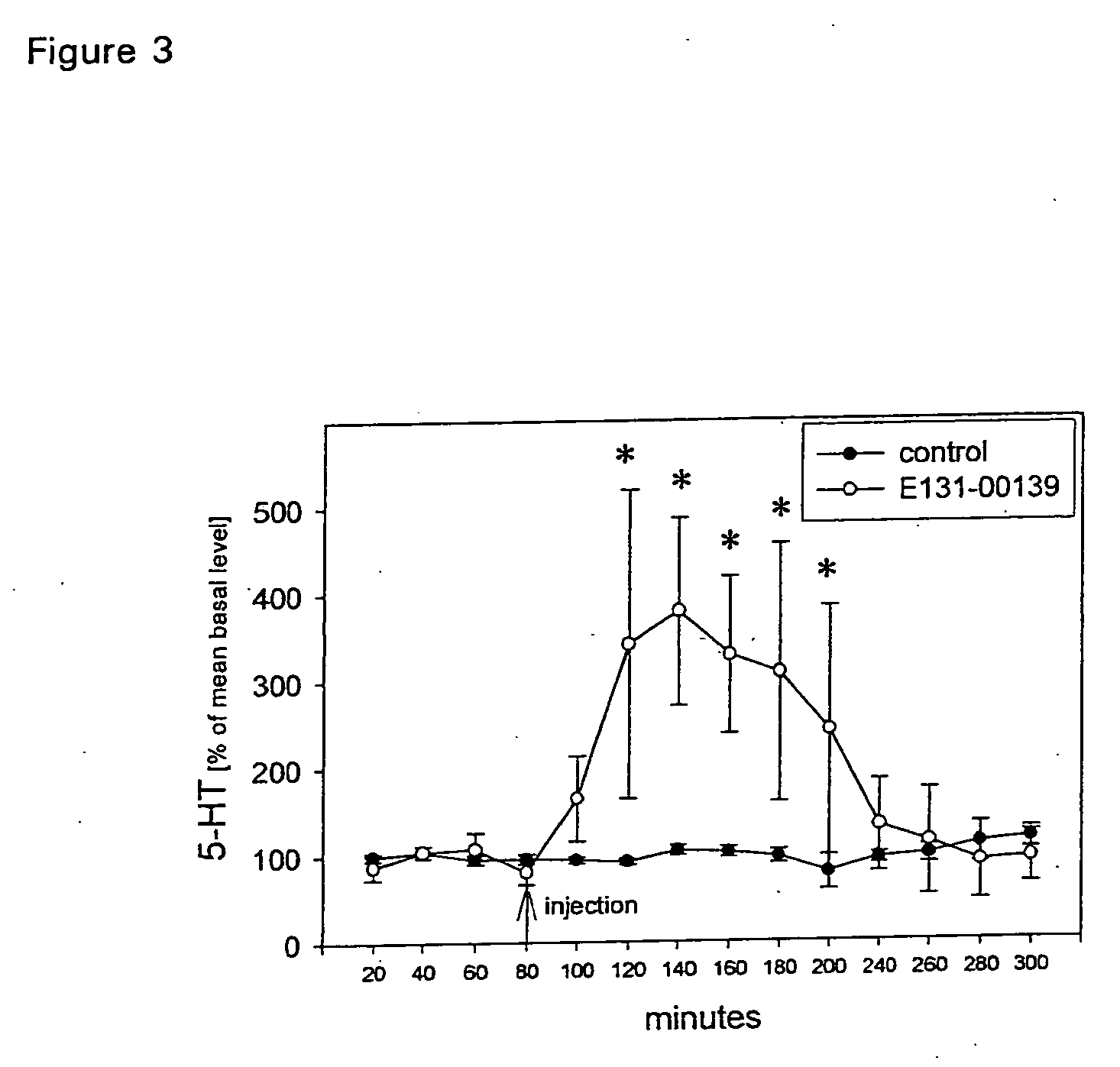Method of treating or preventing central nervous system disorders with compounds having selectivity for the alpha 3 subunit of the benzodiazepine receptor
a technology of benzodiazepine receptor and selectivity, which is applied in the direction of biocide, nervous disorder, drug composition, etc., can solve the problems of patent being extremely agitated and losing contact with reality, affecting daily life, and present psychosis therapy not being satisfactory
- Summary
- Abstract
- Description
- Claims
- Application Information
AI Technical Summary
Benefits of technology
Problems solved by technology
Method used
Image
Examples
examples
1. Treatment of Psychotic Disorders
1.1. Animals
Female Wistar rats (Crl: (WI) BR, Charles River, Sulzfeld,Germany) weighing 150 to 180 g were used for the experiment. They were housed under standard conditions in groups of five on a 12 h light / dark cycle (light on at 0600 h) with ad libitum access to food (Pellets, ssniff M / R 15, Spezialdiät GmbH, Soest / Wesffalen) and water.
1.2. Chemicals
E131-00139 1-(4-chlorphenyl)-4-piperidinoimidazolin-2-one, MW 277.75) was manufactured by elbion AG. Haloperidol (4-(4-[4-chlorophenyl]-4-hydroxy-1-piperidinyl)-1-(4-fluorophenyl)-1-nutanone, MW 375,9) was obtained by ratiopharm GmbH, Ulm, Germany, MK-801 (dizocilpine, MW 337.37) was obtained by Tocris, distributed by Biotrend Chemikalien GmbH, Köln, Germany. All other chemicals used were obtained from Sigma-Aldrich Chemie GmbH, Germany or from Merck, Germany.
1.3. Drug Administration Schedule / dosage
Applied volume: 0.5 ml / 100 gNumberofpre-number ofanimalsDosagetreatmentapplicationRoute of ...
example 4
Subtype selective and partial agonistic effect of ELB139 as an example of a subtype selective partial agonistic alpha 3 preferring compound.
The ligand gated ion channels opened by γ-amino butyric acid (GABAA receptors) are pentamers assembling from two to three different subunits out of an array of six α, three β, three γ, a δ, an ε, a π and a θ subunit (see Hevers et al., 1998). Most likely it is the structural heterogeneity of GABAA receptors that forms the basis for their functional diversity. Most benzodiazepines (BZ) recognising the GABAA receptor modulate Cl− flux through these receptor channels, thereby affecting synaptic transmission in the CNS. For example, the sedative-hypnotic BZ diazepam, used in the present study as a reference compound, imposes a number of effects on the function of the CNS, resulting in a spectrum of-clinical actions ranging from sedation at low doses to induction of anaesthesia at significantly higher doses. Thus, large efforts are made to improve...
example 5
In vivo antidepressant activity of ELB139 as an example of a subtype selective partial agonistic alpha 3 preferring compound in a rodent model of depression
The effect of ELB139 was examined in the rat forced swim test (FST). Depressive disorders, including major depression, are serious and disabling. Selective serotonin reuptake inhibitors (SSRIs) have improved safety and tolerability of antidepressant treatment. However, compliance is often hampered by adverse drug effects, mainly during the initial phases of treatment. The antidepressant efficacy of the SSRIs, particularly in severely depressed patients, is not superior to that of tricyclic antidepressants (about 30% of the patients show no improvement) (Anderson and Thomenson, 1994; Blier, 2001 Anderson and Tomenson, 1994; Burke and Preskorn, 1995). For this reason, there is considerable interest in new therapeutic approaches in the treatment of depression.
Approximately a dozen animal tests for antidepressant agents are used...
PUM
| Property | Measurement | Unit |
|---|---|---|
| affinity | aaaaa | aaaaa |
| receptor affinity | aaaaa | aaaaa |
| concentration | aaaaa | aaaaa |
Abstract
Description
Claims
Application Information
 Login to View More
Login to View More - Generate Ideas
- Intellectual Property
- Life Sciences
- Materials
- Tech Scout
- Unparalleled Data Quality
- Higher Quality Content
- 60% Fewer Hallucinations
Browse by: Latest US Patents, China's latest patents, Technical Efficacy Thesaurus, Application Domain, Technology Topic, Popular Technical Reports.
© 2025 PatSnap. All rights reserved.Legal|Privacy policy|Modern Slavery Act Transparency Statement|Sitemap|About US| Contact US: help@patsnap.com



